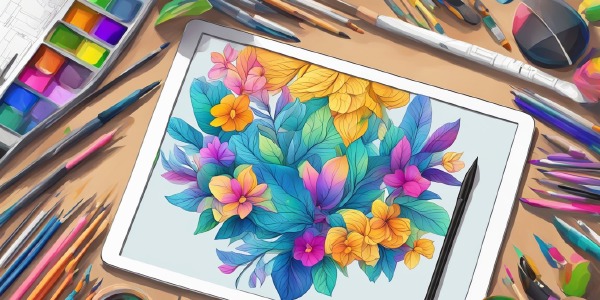Mastering the Basics of Graphic Design with Free Online Tools: A Beginner's Guide
Graphic design is a powerful tool for communication, enabling you to convey ideas and messages through visuals.
As a fundamental skill in the digital age, the ability to create appealing graphics is highly beneficial, whether for personal projects, social media, or professional branding.
With myriad free online tools at your disposal, mastering the basics of graphic design has never been more accessible.
You can start honing your design capabilities without the need to invest in expensive software or formal education.

By learning the principles of design - such as alignment, contrast, balance, and repetition - you establish a solid foundation to build upon.
Free online resources provide you with the flexibility to learn at your own pace. They often offer user-friendly interfaces that cater to both beginners and more experienced users who want to refresh their skills.
This democratization of design education means that anyone with an internet connection and a drive to learn can start creating compelling visual content.
Key Takeaways
- Free online tools make learning graphic design accessible and cost-effective.
- Mastering design basics is essential for effective visual communication.
- The democratization of design education allows for self-paced learning and skill enhancement.
Exploring Graphic Design

Graphic design is a vibrant field that allows you to communicate visually; mastering its basics can significantly enhance your ability to create compelling designs.
Let’s dive into the core aspects that will form the foundation of your graphic design journey.
Understanding Visual Composition
Visual composition is the strategic arrangement of design elements to form a coherent whole. Here are a few key components:
- Alignment: Creates a sharper, more ordered design by ensuring elements are in line with each other.
- Balance: Whether symmetrical or asymmetrical, balance distributes elements so the design feels stable.
- Hierarchy: Guides the viewer’s eyes through a design by using different visual weights.
- Contrast: Utilizes opposing elements like dark vs. light or large vs. small to create interest and focus.
The Role of Typography
Typography is the art of arranging type to make your text legible, readable, and visually appealing. Here are some fundamentals to remember:
- Fonts vs. Typography: While fonts are the different styles of typefaces, typography is the practice of arranging those fonts in your design.
- Introduction to Typography: Start by experimenting with font pairings and understanding how letterform spacing can impact readability.
Effective Use of Color
Color can communicate feelings, create an atmosphere, and draw attention to key areas. Here are aspects of color theory to apply:
- Color Theory: Understand the color wheel, complementary colors, and color psychology.
- Value and Tones: Color value, from light to dark, adds depth, while tones can be altered with gray to change the intensity.
Principles and Elements of Design
Grasping the basic principles and elements of graphic design is crucial. Consider these universally recognized principles:
- Lines, Shapes, and Forms: They encompass the building blocks of composition, from simple lines forming boundaries to shapes and 3D forms.
- Patterns and Textures: They add richness and dimension, enhancing the tactile feel of a design.
Design Software Fundamentals
Knowing your tools is key in translating your ideas into visuals. Explore these popular software options:
- Adobe Software: Programs like Adobe Photoshop and Illustrator are industry standards for their robust features.
- Canva: A free, user-friendly alternative with a vast library of templates.
Learning Graphic Design

Embarking on a graphic design journey allows you to unlock creative potential and communicate ideas visually.
With a plethora of free online tools and courses at your disposal, you can start from scratch or enhance your existing expertise.
Start with Free Online Courses
Free online courses are a great starting point to get acquainted with the basics of graphic design.
Sites like Coursera, Udemy, Alison, and Skillshare offer a range of introductory courses suitable for beginners.
For example:
- Coursera: Partnered with the California Institute of the Arts, Coursera provides courses such as “Fundamentals of Graphic Design” led by renowned experts like Anther Kiley.
- Canva Design School: Offers practical lessons on elements of design and branding suitable for everyday projects.
Specialized Graphic Design Knowledge
Once you have a grasp of the basics, you can explore specialized areas of graphic design.
The areas include logo design, branding, web design, and UX (User Experience) design. Here’s how you can expand your expertise:
- Skillshare: Dive into niche topics like motion graphics or brand systems with short, project-based classes.
- Alison: Provides free courses that delve into strategy and innovation in graphic design.
Developing Your Skills
Practical application reinforces learning. To develop your graphic design skills, you should engage in projects that foster creativity, communication, and collaboration. For practice:
- Use Canva for creating real-world projects like social media graphics or small business branding.
- Seek peer feedback through Coursera’s community forums to refine your communication and collaboration abilities.
Graphic Design History and Theory
Understanding the evolution of graphic design enriches your knowledge base and informs your design decisions. Resources for learning about graphic design history and theory include:
- Maryland Institute College of Art (MICA): Offers online material, such as lectures by Ellen Lupton and Jennifer Cole Phillips, giving insights into design theory.
- California Institute of the Arts (CalArts): Provides a deeper look at design through the lens of cultural and societal development.
Tools and Resources

Choosing the right tools and software can greatly simplify your journey into graphic design. Here you’ll find some essential free online tools to help you grasp the basics of typography, color theory, and layout to create a standout portfolio.
Navigating Design Software
When starting with graphic design, you’ll encounter an array of software options.
For typography and fonts, Adobe Photoshop and Adobe Illustrator offer extensive features, but they can be quite overwhelming.
As a beginner, you can turn to Canva, which is user-friendly and provides a wide selection of typefaces to experiment with.
For learning color theory and mastering shape and layout principles, Kadenze and Coursera offer free courses that you can take at your own pace.
These platforms cover basic and advanced techniques, allowing you to integrate this knowledge into your designs effectively.
Strengthen your software skills with Canva Design School and Skillshare, where you can find tutorials that guide you through the different functionalities of Canva, Photoshop, and Illustrator.
Watching these tutorials will give you a clearer understanding of how to apply your ideas to actual projects.
Finding the Right Resources
Fostering your design skills necessitates having access to a vast array of resources.
For graphic elements and templates, Canva provides an extensive library that is ideal for crafting quick and stylish designs. Meanwhile, for those looking to specialize in lettering, True Hand offers resources that give you a taste of hands-on typography.
Building a portfolio is made easier with platforms like Adobe Portfolio, which is free with an Adobe Creative Cloud subscription. If you’re not ready to commit to Adobe’s suite, there are other free alternatives available online where you can showcase your work.
Continuously expand your knowledge by enrolling in classes on platforms such as Creative Live and LinkedIn Learning.
They provide lessons ranging from the very basics to more advanced techniques. TableRowHere is a concise table to guide you through key resources:
| Software/Platform | Free Access | Features |
|---|---|---|
| Canva | Yes | Drag-and-drop interface, pre-made templates, fonts, shapes |
| Adobe Photoshop | Limited Free Trial | High-quality photo editing, custom typography, advanced layout |
| Adobe Illustrator | Limited Free Trial | Vector graphics, intricate typography options, professional layout |
| Kadenze | Yes (for many courses) | Free courses on art, design, and technology |
| Coursera | Yes (audit mode) | Wide range of courses, including graphic design fundamentals |
| Skillshare | Limited Access with Free Account | Classes on various creative skills, including software tutorials |
| Creative Live | Free Live Classes | Workshops and courses taught by industry professionals |
| LinkedIn Learning | One Month Free Trial | Extensive library of business and creative courses |
Application of Graphic Design

Graphic design is an expansive field, touching everything from brand creating to delivering user-centric experiences. Here, you’ll learn how to apply design fundamentals through free online tools to embark on various creative endeavors.
Design Projects and Practice
Your journey in graphic design starts with consistent practice.
Through online platforms, you can take on design projects that refine your skills in typography, layout, and composition.
Practice using grids and creating mood boards; these will help you develop visual communication that resonates with viewers.
- Typography: Experiment with font pairing by designing a simple flyer.
- Layout: Create various web design mockups to understand visual hierarchy.
- Composition: Utilize free design assets to construct storyboards for social media campaigns.
Creating a Professional Portfolio
A well-crafted portfolio is your ticket to professional recognition.
Use free tools to showcase your logo designs, branding projects, and other creative works. Highlight how you apply graphic design principles to create cohesive and aesthetically pleasing visuals.
- Logo Design: Include various iterations to show your creative process.
- Branding: Demonstrate your ability to convey brand emotion and storytelling.
- Presentations: Display how you’ve used design to communicate complex information effectively.
Career Pathways in Graphic Design
In graphic design, career opportunities are vast.
You can explore roles in advertising, web design, or become a branding specialist.
Each requires a strong understanding of user experience and the ability to craft appealing visuals that drive engagement and convey clear messages.
- Advertising: Pair copy and visuals to design compelling ad campaigns.
- Branding Specialist: Construct entire brand identities that communicate a company’s mission and values.
- Web Designer: Focus on creating websites that are both aesthetic and functional, ensuring a positive user experience.
Building Your Brand and Presence
Having a unique personal brand and online presence is essential in setting you apart.
Through innovation in design and a strategic approach, you can attract a network and open doors to new opportunities. Share your work on social media to engage with the community and potential clients.
- Personal Brand: Use recognizable brand logos and a consistent color palette across all platforms.
- Online Presence: Implement SEO strategies in your portfolio to improve visibility.
- Social Media: Share behind-the-scenes, work-in-progress, and final pieces to tell the complete story of your projects.
Beyond the Basics

As your graphic design skills grow, unlocking advanced techniques and exploring current trends will significantly enhance your creative projects. It’s also key to connect with other designers and understand how motion plays a role in user experience.
Advanced Techniques and Trends
Keep pace with industry trends and leverage innovative software features to push the boundaries of your creativity.
Explore advanced color theory to evoke the right emotion and storytelling in your designs. Learn about scale and its impact on visual communication:
- Scalability: Ensure your designs maintain visual integrity on different platforms.
- Color Psychology: Use colors strategically to convey emotion and messaging.
Staying current also involves using computer graphics to create complex textures and incorporating motion graphics for dynamic compositions.
Aspects of UX design become pertinent when your graphics intend for interactive mediums.
Collaborative Design and Networking
Developing professional relationships is vital, and online tools often have built-in features for collaboration:
- Feedback Loops: Keep multiple iteration cycles with peers to refine designs.
- Online Communities: Engage in forums or platforms like Behance or Dribbble.
This networking can lead to community engagement, allowing you to understand and meet your audience’s needs better and creating a support system that fosters growth and opportunity.
Graphic Design in Motion and Interaction
In today’s fast-paced digital world, integrating motion and interactivity makes designs come alive and enhances the user experience. Consider the following:
- Motion Graphics: Use tools like Adobe After Effects or Blender for innovative animations that tell a story.
- Interactivity: Incorporate elements in your design that respond to user actions to make your UX design more engaging.
Concluding Remarks

Becoming proficient in graphic design is a journey made easier with the plethora of free online tools at your disposal.
Remember, mastering the fundamentals of graphic design is essential, and these platforms are an outstanding resource to hone your skills.
Your creativity shouldn’t be limited by costly software.
Instead, tapping into the wide array of free tools not only nurtures your creative flair but also aids in meticulous planning and precise execution of your designs.
- Explore: Experiment with different tools to discover which ones resonate with your design style.
- Practice: Regular use will improve your proficiency and confidence.
- Learn: Take advantage of tutorials offered by these platforms to expand your knowledge base.




